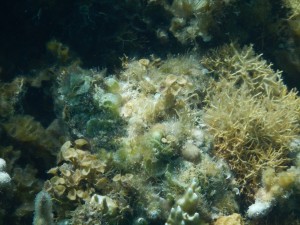My greatest accomplishment of today was conquering my inability to swim to depths. This day was undoubtedly the most physically demanding we have had so far. In the morning, we took the boat to the fore reef, outside of the bounds of the atoll. This meant that the water was much choppier than previously. I was worried that I would get sea sick, as the last time I was on a boat, I definitely did. In the end, I was one of the few that didn’t end up feeling bad at all.
The fore reef was amazing. It was in a completely different scale from everything that we have previously seen. According to Adrienne, the deepest part that we went to was about fifty feet. Of course we didn’t free dive that deep but we did in some of the medium depths. I was really excited about how much I improved from the first time that we entered the water. By the end of the day, I could make it down the bottom in places that were much deeper than I ever expected from myself.
I continued to see soft corals all over the reef. At this point, I don’t that the composition of this particular community dramatically changes over the different areas that we have been too. I am consistently seeing this community dominated by Gorgonia ventalina in every location.
While I don’t know what we are doing tomorrow, I think that it involves marine debris. This will be a good transition into more conservation-focused issues. I also can’t believe how few days we have left. As per usual I feel simultaneously prepared and unprepared. We shall see how the last couple of days go. I’m sure they will be just as amazing.
.
Monthly Archives: May 2016
Outer reef and back reef adventures, Day 12
This morning we loaded up the boat really early and travelled a short distance to the reef crest and fore reef near Middle Caye. I took Dramamine an hour before we left and I will spare you the wait and just tell you that I in fact felt queasy out on the ocean. Once we got to the first site, we all got off and it was quite deep, around 50 feet. I was able to dive all the way down and stay long enough to get some really cool photos. After that we moved to the reef crest, where we saw a few stingrays and an eagle ray (which was humongous!) I saw a new coral, Agaricia tenufolia and also spotted quite a bit of the Orbicella faveolata and O. annularis, as well as Montastrea cavernosa.
I tried to be the last person on the boat, but even then I still felt crappy due to the swells. We headed to the second site and jumped in. All of a sudden I hear people exclaiming that there was an Acropora palmata! This coral has been nearly wiped out in the Caribbean due to White Band disease and so I had really wanted to see one. I think I saw about six different colonies during this snorkeling adventure. I can only imagine how magnificent the reefs must have looked over one hundred years ago when A. palmata was a dominant reef builder that loomed over the reef like trees in a rainforest.
I was happy to get back to shore and immediately collapsed into my bed with peanut M&M’s, plantain chips, and oreos all by my side. That afternoon we went over our results from the reef health assessment experiment (coral cover and urchin data). Then we explored the backreef and that was really awesome. I saw so many interesting things, such as a coral with a tumor, a recently dead skeleton of a Siderastrea siderea that was of mysterious origin, and another giant lobster. Scott and our water safety officers were also simultaneously catching lionfish. We caught four and at the end of the week we are going to measure them and then prepare and eat them.
I feel very tired at the moment, most likely from all the swimming from today. Au revoir.
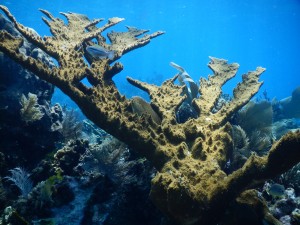
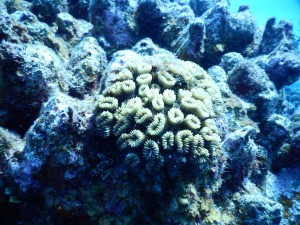

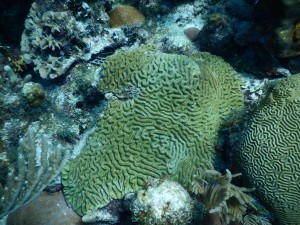
Day 12: Shallow Surprises, Deep Mysteries
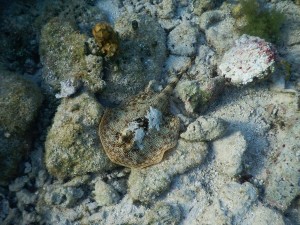
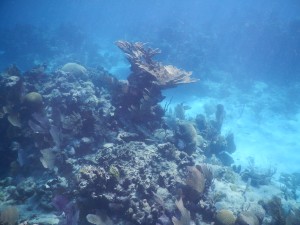
I think I’m beginning to realize why people are so obsessed and interested on corals, which on the outside look like colorful pieces of rock. Not only are these rocks filled with living polyps, but they also are sensitive to changes to things like temperature, depth, light, and ocean salinity. One thing I saw was how the composition of corals changes dramatically with a few feet of depth change along a gradual slope on our deep-sea dive to the fore-reef. Towards the shallows, you find aerodynamic, small, floppy corals that can stand the power of the waves, while the deeper corals are larger in magnitude, forming magnificent mounds.
We took a second dive in a shallow reef bed called the back reef, where in just four feet of water you can find an incredible diversity of animals and plants, ranging anywhere from coral polyps, to anemones, to stunning reef fishes, to lionfishes, to giant stingrays, to giant barracudas. This incredible diversity is due to the placement of this reef in Glover’s Atoll. Think of an atoll as a ring of corals with wind blowing on one side of it. Depending on the orientation with respect to the wind, you can get completely different colonies of coral reefs with different compositions and abundances of other creatures.
Unfortunately, even after going through two extremes of reefs, I couldn’t find even one jellyfish or jellylike creature. I’m wondering what about the rich nature of the reefs makes jellyfish life so difficult. Jellyfish tend to proliferate in areas of high nutrients. If what my colleague’s lecture on nutrient cycling on the reefs is correct, then the lack of available nutrients in a diverse ecosystem like a coral reefs would prevent growth of jellyfish in the area. So far, the jellyfish I’ve spotted where either photosynthetic jellies like the Cassiopea species that lived in the shallows near the mangroves, or by accident like the mangled box jellyfish.
Well, either way, I’ve got some neat shots of things outside of my taxon group, and I hope you enjoy them when I upload them!
Day 12: Open Ocean Adventures
I might finally appreciate the vastness of the ocean. This may sound obvious, and I’ve always known that the ocean was huge, but I don’t think I ever really understood what that meant. This morning we went to the fore reef, which was far deeper than anywhere I’ve swam before. Although the water was crystal clear, I couldn’t see the bottom in many places, and in most directions there was nothing but blue for as far as I could see. It hit me that although I was awestruck by the apparent limitlessness of this ocean, I could only see a tiny speck of the ocean on a globe. I know I’ll never fully understand how large the ocean is, but at least now I have some perspective on its immensity.
We saw many incredible species today. On the fore reef, we saw many large rays, including a spotted eagle ray that was easily longer than I was. We also saw some large, highly endangered elk horn coral. After lunch we snorkeled out to the back reef and saw a large barracuda and caught several invasive lionfish. I didn’t see any tunicates, but I did find nearly all the calciferous red algae species I had researched. Tubular thicket algae and Amphiroa fragilissima were quite common on the sea floor, as they were in the unprotected patch reef yesterdat. I also found crustose coralline algae covering some patches on the reef framework, and a few Galaxura Rugosa plants as well.
Day 11: Sea Urchins and Shooting Stars
Today we took a boat out to snorkel a little farther from the station. We visited two patch reefs, one in the Marine Protected Area and one outside of it. At each reef, we measured stony coral and macroalgae cover to learn about the reef’s health. In addition, we collected sea urchins at each site, to learn about their relative size and abundance. Urchins are important for reefs because they feed on macroalgae, but they also bore into stony corals. If they become too abundant they can do more harm than good and fragment the reef framework.
We haven’t finished our data analysis yet, but some differences were immediately apparent. The stony corals in the marine protected area were much larger and denser, and the sandy patches between corals were often bare. In the unprotected area, large stony corals more spread out and the reef was dominated by soft corals. Most of the area we surveyed was sand rather than reef. These areas were full of sea grass and red algae, contrasting sharply with the open areas of the protected reef. I still haven’t seen a tunicate, but I saw several species of red algae. The most common, tubular thicket algae and Amphiroa fragilissima, covered the sea floor in the unprotected area.
This evening we put a light out under the dock, hoping to attract some interesting species. We only attracted minnows and shrimp, so eventually we turned off the light and looked at the stars instead. Lying on our backs, watching shooting stars, was easily my favorite part of today. We usually keep pretty busy, and it was so nice to have the chance to step back and fully appreciate this beautiful place in which we live.
Snorkel Day + Sea Cucumbers
Hi everyone! What a day! This morning we learned about reef zonation and took a boat ride outside the calm waters of the reef crest and into the higher energy fore reef to explore the organisms (in particular the coral) outside the atoll. There I spied some small reef urchins (Echinometra viridis) buried in the crevices among the large coral. Amazingly, we also got to see a couple larger marine creatures out in the fore reef. We all watched in wonder as an enormous spotted eagle ray glided along the benthos and a nurse shark navigated its way through the coral.
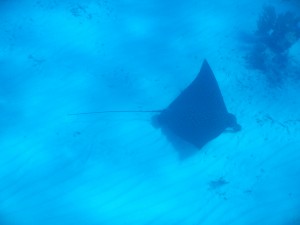
Our afternoon time in the water was spent on the shallow back reef much closer to the island. This area was just as interesting as the fore reef to me, and I got to hold several donkey dung sea cucumbers (Holothuria mexicana) that were about a foot long and on the sand among the sea grass on the edges of coral. The back reef was also neat because I got to swim alongside many schools of fish. While we were at the back reef, we also managed to spear some lionfish, an invasive species from the Indo-Pacific that consume many native species of fish, to study and make ceviche out of later on. I can’t wait to see how that will go! 🙂

Day 12: Fore reef, back reef

To start off this morning we ventured outside of the atoll’s lagoon to the fore reef. The fore reef is the outer edge of the reef and has the highest diversity of any reef zone. However, the fore reef also has the highest wave energy and is much deeper than the lagoon or back reef. The boat ride to the drop zones was pretty choppy, which was a bit of a challenge for some people, but most people were able to enjoy the reef once they got off the boat, and we didn’t have any vomiting.
I found it harder to see details on the fore reef because it was deeper and I couldn’t dive far enough down, but I was still able to see interesting aspects of the fore reef. There were bigger fish than in the lagoon, and I believe that the diversity of fish species may have been greater as well. The coral on the fore reef was also amazing because it had more space to grow, so the colonies were much larger. We even saw some Acropora palmata colonies, which is a species of coral that used to be a dominant reef builder but recently saw enough colony death to make it endangered. I also enjoyed seeing Acropora cervicornis because it has distinct white tips with an apical polyp that is much larger than the rest of the coral’s polyps. I learned about A. cervicornis in a class that I took last semester, so it was cool to be able to see it in person.
While we were on the fore reef we also saw a huge ray swimming across a sandy area and a nurse shark that followed our group for a while as we snorkeled alongside the reef crest.
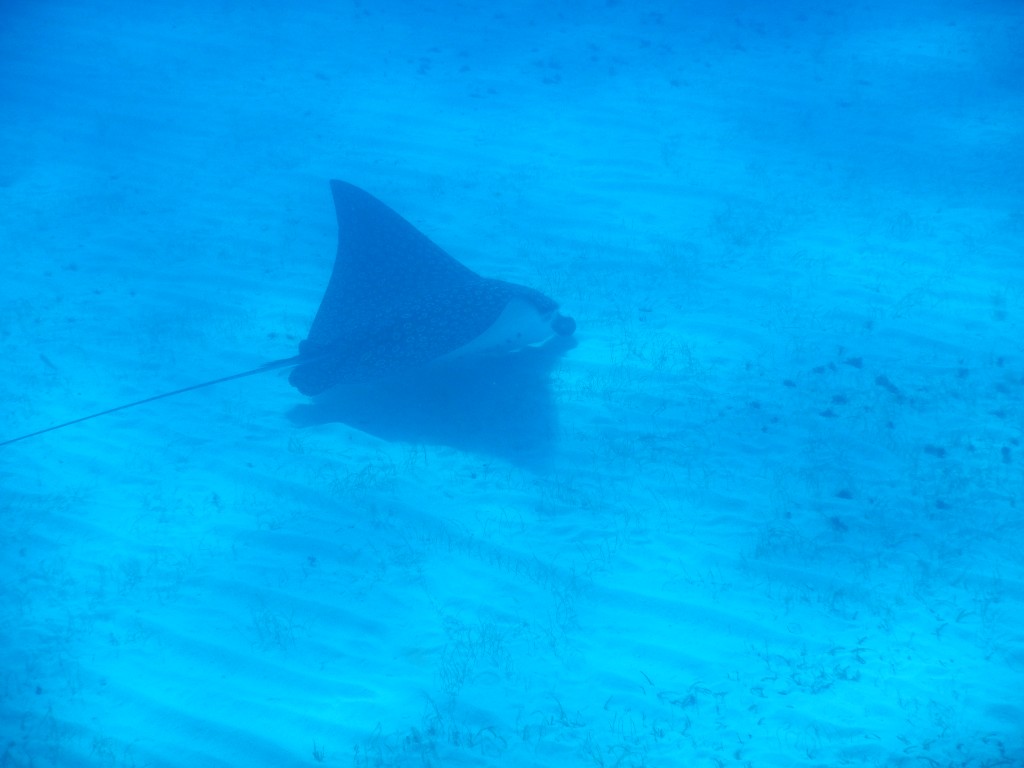
In the afternoon we were able to go out on the back reef by Middle Caye. The water was around three feet deep, making it difficult to navigate, but we were able to get closer to the sea floor than we had been able to before. This was especially beneficial for viewing green algae, as they flourish in areas with high sun and sand. I saw a number of species of Udotea, Caulerpa, and Penicillus all in close proximity. These three species were all found on the sea floor in sandy areas or on dead corals that had accumulated a large amount of sediments. Some species of Halimeda were also found in sandy areas on the sea floor, but some were growing in crevices found on corals. The Halimeda on the floor were taller and had smaller segments, whereas the species on corals were more clumped and had larger segments
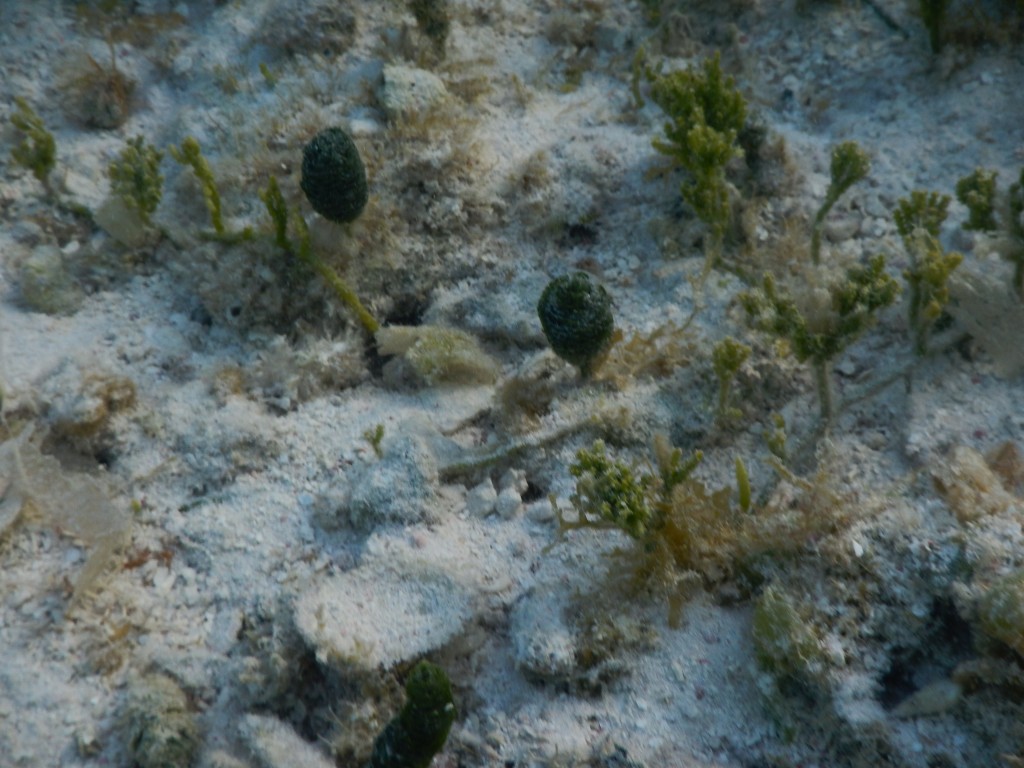
The back reef had the first lionfish that we were able to spear. While on Middle Caye, we aren’t permitted to eat any fish that we catch other than lionfish, because they are invasive. Tomorrow we will be taking measurements of the four lionfish that we caught and then we’ve been promised lionfish ceviche, which sounds delicious!
Reef Exploration
Day 12 was all about atoll structure. We did two snorkeling swims today on different parts of the atoll. In the morning, we visited what is known as the fore reef, which is the part of the reef outside of the atoll’s ring of reef crest. The afternoon’s snorkel was on the back reef, the section of the reef near the reef crest on the inside of the atoll.
The fore reef snorkel was incredible, up until the point where I started feeling sea sick and had to lie on the floor of the boat (along with all the other nauseous people) for the rest of the trip. Before that, though, I got to explore the deeper reefs of this area. Three southern stingrays were seen on the sandy bottom between sections of reef. The coolest sighting of the day was of a huge spotted eagle ray near the deepest part of the reef. At one point the creature flipped around, ate something, and then swam off into the depths.



After finishing some data analysis for our reef health study from yesterday (relatively inconclusive), we took to the waters again, this time to explore the shallower, calmer back reef. The area was a mix of sea grass, sand, and coral areas, and the species were very diverse. I saw many bluestriped and French grunts swimming between the corals, along with a five-foot long barracuda! I also saw a sharptail eel swimming around in the rubble, another southern stingray, and a smaller barracuda chasing after some unknown species of fish.

Today was also special in that we got a very interesting presentation from Javier Garcia about the history of Belize’s people. It’s incredible how diverse both the human and wildlife populations are here!
One Reef Two Reef, Back Reef Fore Reef
Today was an exhausting day of snorkeling. We boated out to the reef crest, where the wave action from the ocean meets the high island of the atoll. Here we experienced the windward fore reef. This area of the reef is characterized by high wave energy, resulting in larger, more robust boulder corals. The depth of this area was a significantly greater challenge to traverse than the reefs in the lagoon yesterday. At first I could hardly stay under water long enough to even get close to the corals and other creatures below. But as the day went on my lungs stretched and I surprised even myself by free diving more than twenty five feet to snap a video of a large spotted eagle ray on the ocean floor. I’m no fish, but I certainly improved today!
As far as sponges go, I’ve been seeing most of the same stuff I mentioned earlier this week on every reef. Today was an exception, I saw Xetospongia muta the Giant Barrel Sponge. This guy lives in deeper water, so today was the first opportunity to see it. I’ve also been seeing quite a bit of the boring sponges of the genus Cliona.
After the fore reef in the morning, the majority of the group had gotten a bit sea sick, so we stuck to the shallower back reef in the afternoon. Here we saw the most concentrated variety of life so far in the atoll. Anemones, giant spiny lobsters, and so many fish you would swear we were diving in an aquarium. Here Dr. Solomon showed off his manly prowess by spearing three lionfish. While you might be thinking this to be some mark of hubris, it was actually quite selfless to do this, as lionfish are an invasive species whose extraction spells good news for any native fish in the area. I’m sure they’re delicious, so more people should be removing these nuisances from the Caribbean and turning them into ceviche.
Team Surf
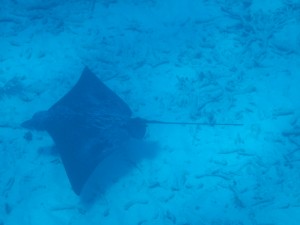
I’ve come out of day 12 of this trip with a whole new appreciation for land. We leveled up on our boating expedition today by traveling outside the reef crest and the calm waters of the Glover’s Reef. The morning’s topic was reef zonation, so we ventured into the open ocean to check out the coral ecosystems beyond the atoll. In these deeper reefs, I saw a lot of larger herbivorous fish, especially terminal phase parrotfish. I was able to identify conspicuous males of the striped parrotfish (Scarus croicensis) and some female/primary male stoplight parrotfish (Sparisoma viride). But the real excitements of the morning were our carnivore sightings; we watched a giant spotted eagle ray fly across the benthos and a nurse shark glide through mountains of coral.
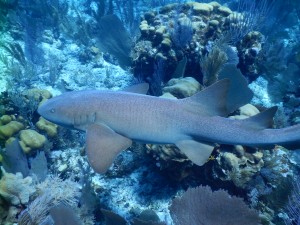
However, the choppy waves weren’t as appealing from the boat as they were on the reef. Thankfully every TFB came out of this experience unharmed, but I think a few of us might be jumping ship from team surf for the moment (sorry, Adrienne).
The afternoon’s snorkel was spent on back reef just in sight of the island, ending our boating adventures for the day. Though we couldn’t have been in more than 3 feet of water, the mix of seagrass and corals produced a scene reminiscent of Finding Nemo (sorry again, Adrienne). I swam right
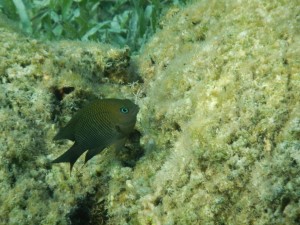
past a whole school of ocean surgeonfish (Acanthurus bahianus) and found tons of small dusky damselfish (Stegastes fuscus) tending to their algae gardens. Since these reefs were much smaller, I didn’t see any large parrotfish here, but I did find a number of tiny juvenile striped parrotfish (Scarus croicensis)—these seem to be common on shallower reefs. But the primary objective on the back reef was spearing lionfish, an invasive species from the Indo-Pacific. We managed to collect quite a few specimens for studying (and cooking) later in the week.
All in all, today gave me a new appreciation for both the ocean’s beauty and the wonderful stability of turf.


